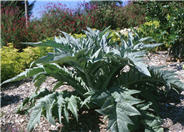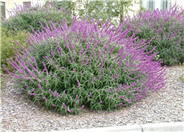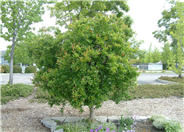
Common name:Artichoke
Botanical name:Cynara scolymus
This perennial will grow 4' tall and 6'-8' wide. It has silvery green leaves with bluish purple flowers that bloom in spring. Artichoke is a favorite fruit/vegetable of California kitchens but it is a great ornamental plant often overlooked for color contrast. It is very tolerant of little water when planted for ornamental purposes.

Common name:Rosemary
Botanical name:Rosmarinus officinalis
Rosemary is hardy in full sun areas where winter temperatures do not drop below 10 degrees F. They can be grown in a clay pot with well-drained, porous soil in bright indoor light, and will also flourish on the backporch in spring, summer and fall. Its beautiful, slowly trailing stems and shiny slender leaves are perfect for showing off the small, light blue flowers that blossom in the summer. -Holland WIldflower Farm

Common name:Mexican Bush Sage, Velvet Sage
Botanical name:Salvia leucantha
The Mexican Sage is a bushy shrub that grows 3'-4' tall and wide. It has hairy white stems, gray green leaves and velvet-like purple flower spikes that bloom summer through fall. This shrub tolerates sun, light shade, little water, and is hardy to 15 degrees F. The Mexican Sage is drought tolerant and attracts hummingbirds. -Cornflower Farms

Common name:Pomegranate
Botanical name:Punica granatum
This small tree or large shrub is very attractive (edible) and ornamental. It is naturally rounding; it can reach 15'-20' tall and wide. It is often pruned into a single trunk tree and kept as a shrub, being used as a hedge row. The baseball sized fruits are usually red. The nutritious edible aggregate-berries (arils) are variably sweet, succulent and tangy. 'Wonderful' is a common cultivar. 'Sweet' has yellow flowers and 'White' has very light pink flowers.
| Designer: Homeowner | Raised Vegetable Garden Area |
Photographer: GardenSoft |
Soils and Compost:
Practice grass-cycling by leaving short grass clippings on lawns after mowing, so that nutrients and organic matter are returned to the soil.
Water Saving Tip:
Replace turf with groundcovers, trees, and shrubs. If you have areas where no one uses the grass, patches that do not grow well, or a turf area too small to water without runoff, consider replacing the turf with water-efficient landscaping.
Integrated Pest Management:
Remove irrigation water and fertilizer from areas where you don't want weeds to grow.
